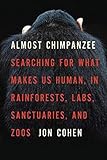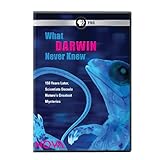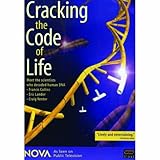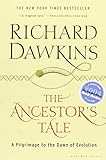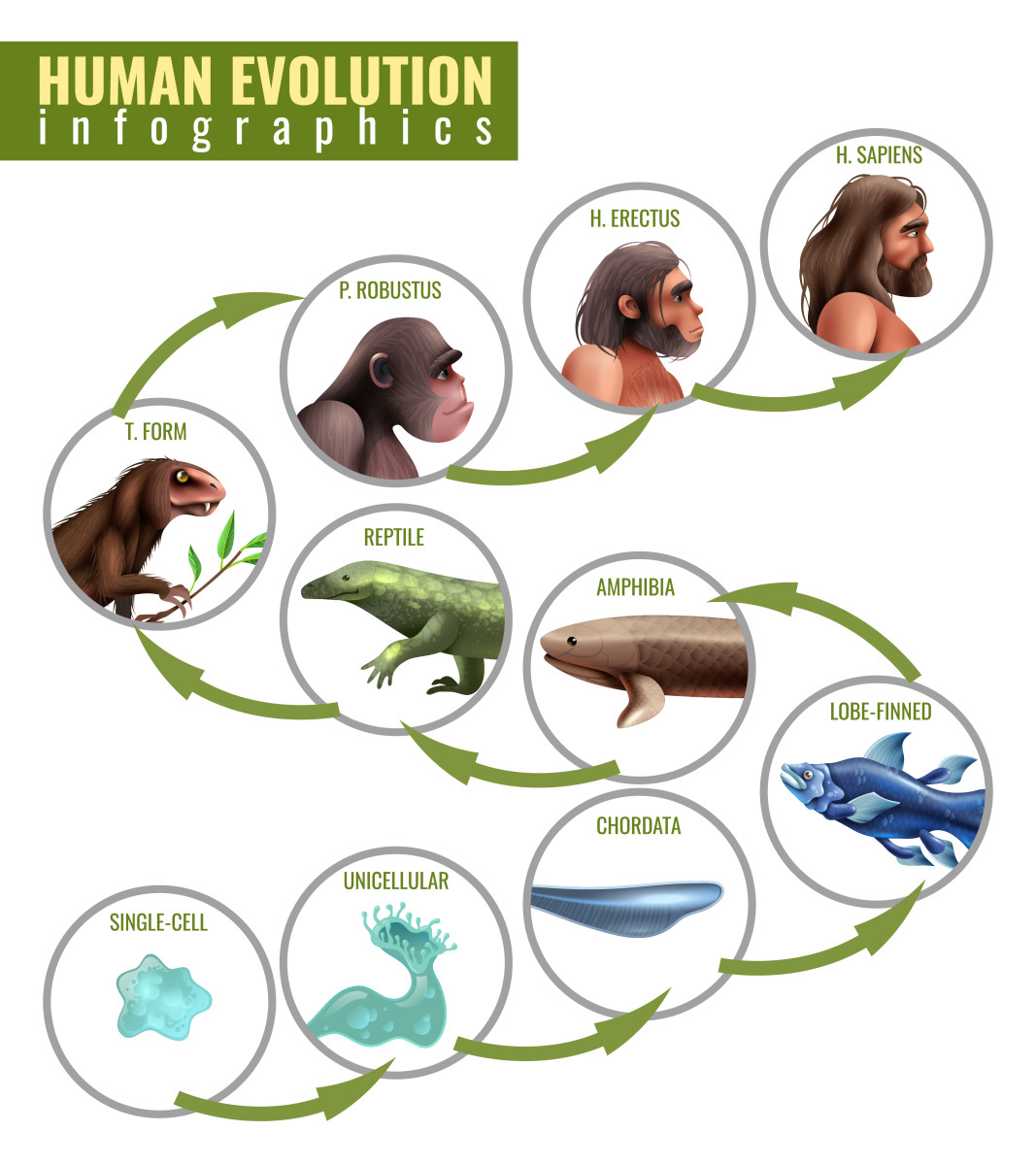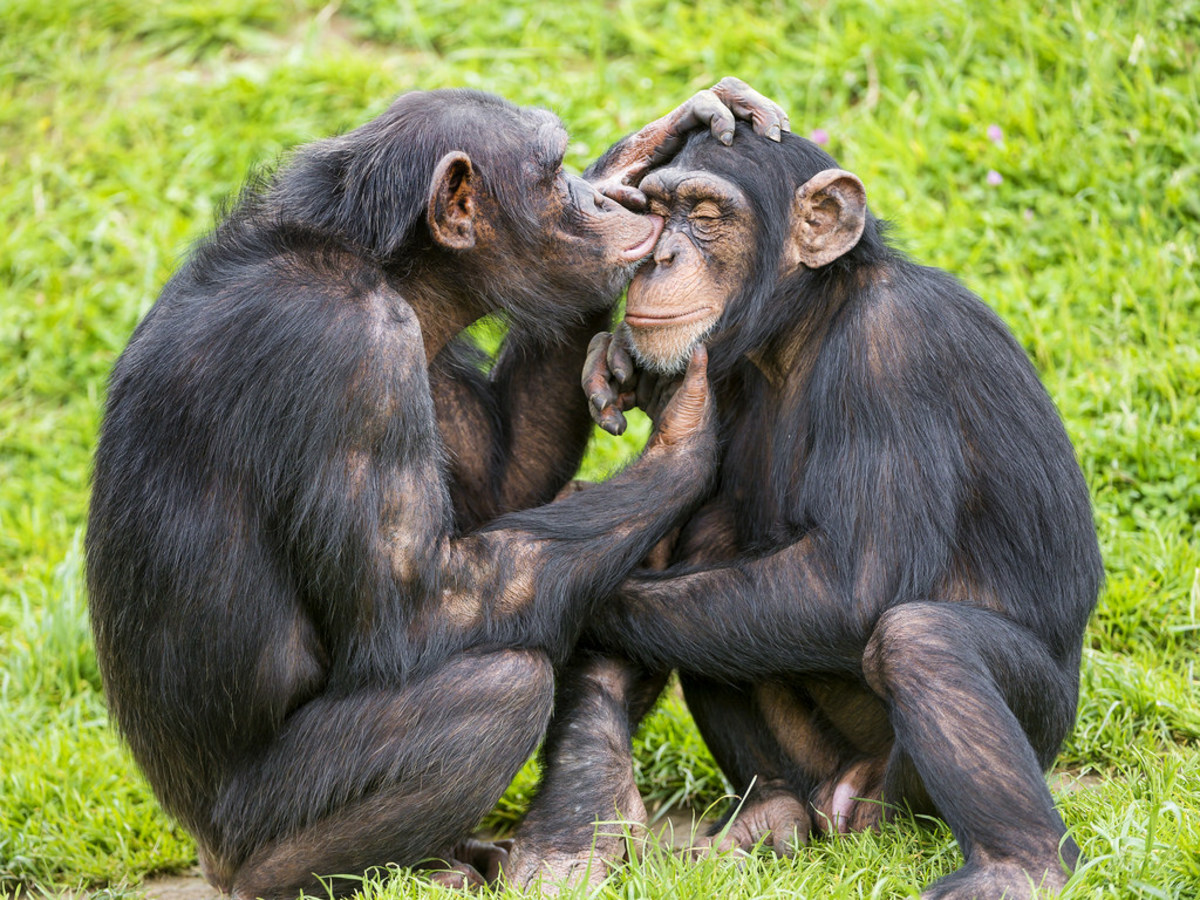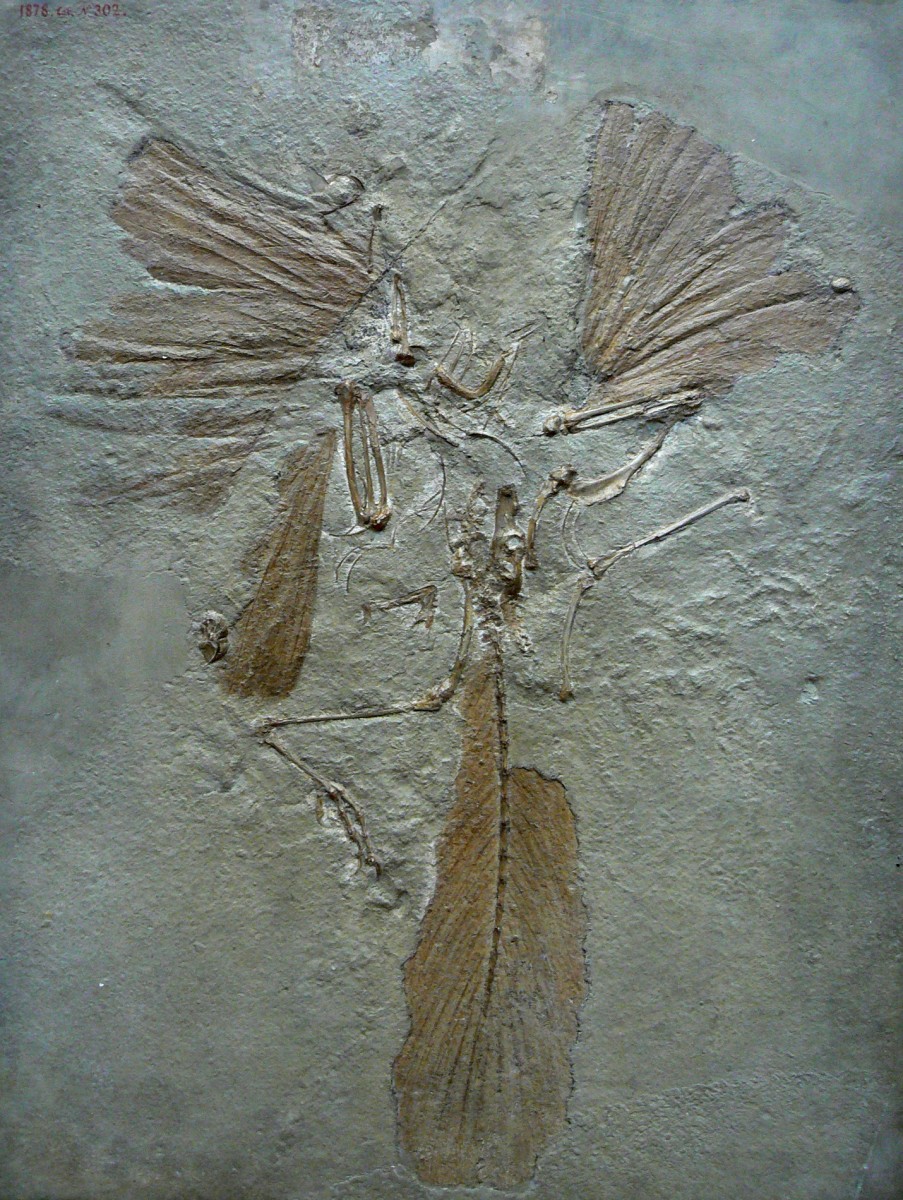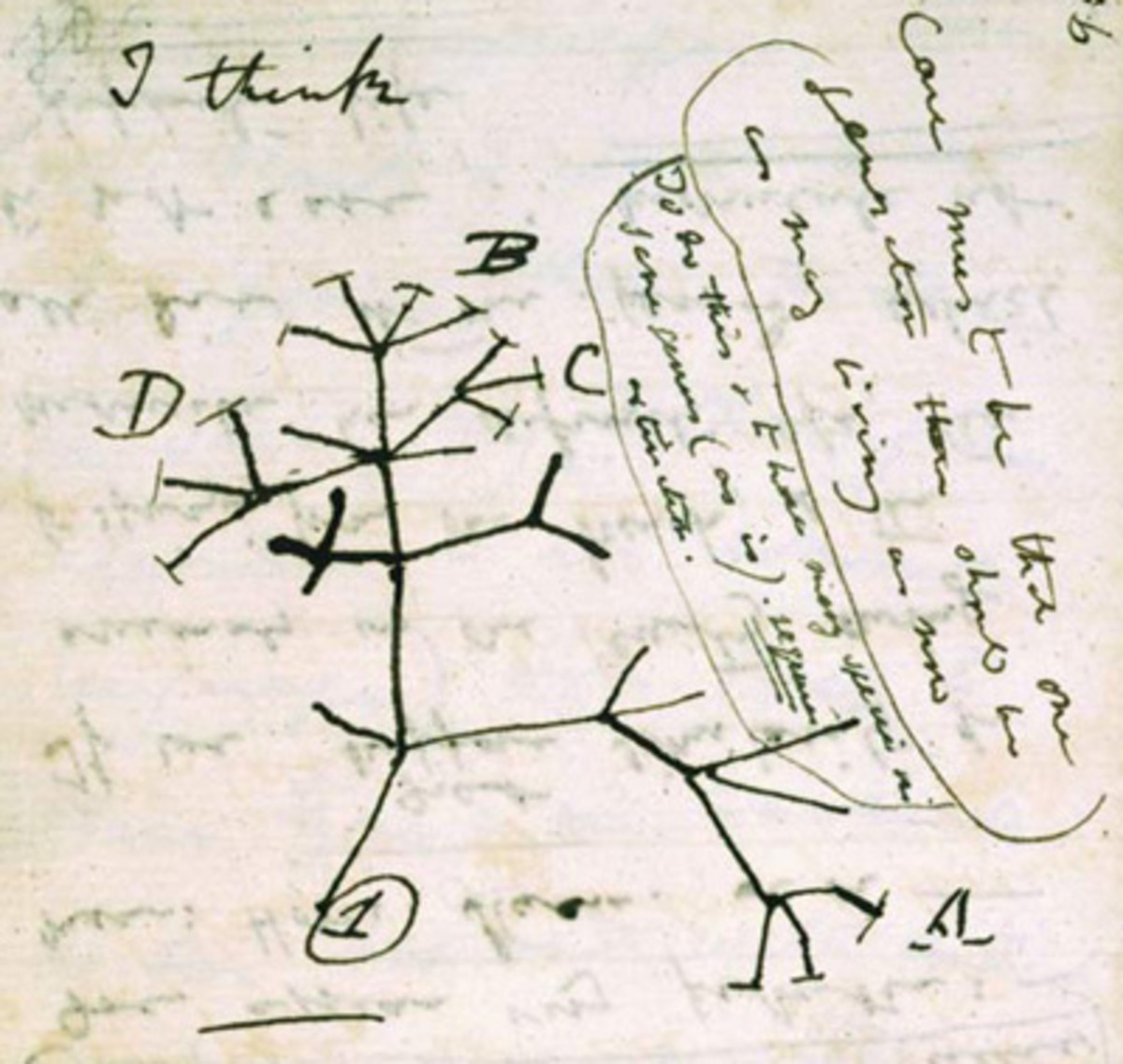The Human Difference: Chimpanzees and Bonobos - Men and Women
Bonobo
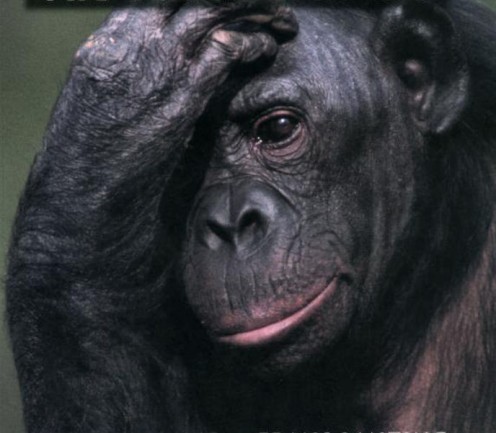
Like Chimps ~ But Not That Much Like Chimps.
Although I accept evolution as true, there is something that has been bothering me for some time.
I know that, genetically, we humans are more closely related to chimpanzees, than chimps are to gorillas, but that fact certainly is not obvious to the beholder.
Most people can see a strong resemblance between chimps, bonobos, orang utans, gorillas, baboons, monkeys, etc, and even something of a resemblance with humans, but most people would assume that it is the hairy apes and monkeys that would be more closely related ~ not the 'naked ape' (as Desmond Morris calls humans).
Why is it, I keep wondering, that humans seem so different from the other apes, in spite of the closeness in DNA?
Why do gorillas look more like chimps than we do, even though they are more distantly related?
What is the human difference ~ and what causes it?
* * * * * *
Naked Ape

And it is not just in looks!
The major difference is probably brain use and brain power ~ the way we think and what we can learn.
Is it true that this is where God comes into the equation?
Or aliens, even ~ as some people believe?
Monkeys Look More Like Chimps Than Humans Do!?
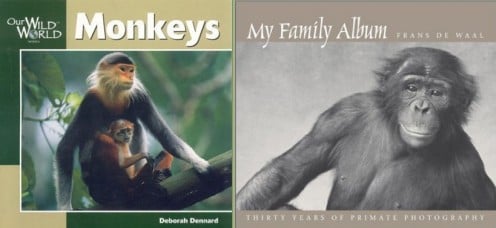
Earlier Humans

Go Ask the Chimps!
After a book presentation on genetics ~ during question time ~ I once asked a well-known and respected geneticist a question which had long been gnawing at me;
~ why was it, that, though we are more closely related to chimps than chimps are to gorillas, chimps still look closer to gorillas and we seem very different.
His answer?
'Why don't you go ask the chimps!'
That was when I started to realise that the experts didn't know the answer, either!
Chimpanzee and Bonobo - Our Closest Cousins
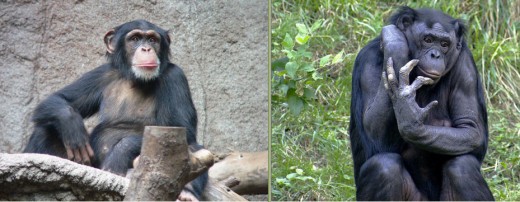
Evolutionary Psychology and the Mind
DNA Similarities and DNA Differences
I watched a documentary on evolution, which included coverage of this subject. It was called 'What Darwin Never Knew'' and it was shown in Darwin’s anniversary week (Feb 2011).
I hoped to get some answers.
*
So what does make humans different?
Is it that we have more genes than any other creature?
(I understand that many people thought that this must be the case ~ including scientists)
But no!
According to the documentary, we have the same number of genes as a chicken, and fewer than a maize / corn plant.
Surprising!
Are these genes very different, then, from those in other animals?
It appears not.
Many were identical in humans and in other creatures.
These results may not be the ones expected, so what is the answer to the puzzle?
It’s not the number of genes, or the mutations in these genes ~ so what causes ‘the human difference’?
It seems that the answer lies in the parts of the DNA not classified as ‘genes’.
So what can be found in our DNA?
There are genes, switches and bodyplan DNA.
And these three types could explain the difference between us humans and other animals ~ including our closest relatives, the chimps
The Evolution of Mankind?
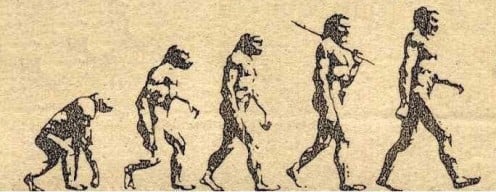
99% Similarity : 1% Difference
Our closest relatives are the chimpanzees and the bonobos. We share approximately (slightly less than) 99% of our DNA. That is a very close relationship!
Yet we are noticeably different.
In spite of their obvious talents, chimpanzees do not do what we do. They do not study astronomy, or build rockets to explore outer space. They do not join Internet forums, in order to discuss religion and philosophy. They do not write symphonies or choreograph ballets.
They are very able, though. We must not under-estimate them. They can use tools. They can learn to communicate via sign language. They have even beaten humans in an IQ test.
But they are not human ~ not quite. There are subtle but very real differences.
Why?
What causes those difference?
Our DNA may be 99% similar, but it is 1% different. And that difference may be very important!
Some of Frans De Waal's Books:

Frans De Waal
"One can take the ape out of the jungle, but not the jungle out of the ape. ~ This also applies to us bipedal apes."
Frans De Waal ~ 'Our Inner Ape: A Leading Primatologist Explains Why We Are Who We Are'
A quote from Frans De Waal, on Amazon:
"For me, there is nothing more logical than to look at human society through the lens of animal behavior."
Website of Frans De Waal:
http://www.emory.edu/LIVING_LINKS/empathy/author.html
Geladas - Old World Monkeys
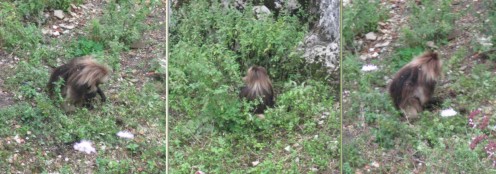
DNA - The Double Helix
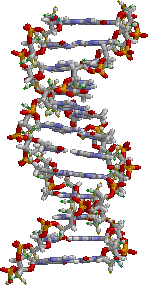
The One Per Cent
One percent sounds like a trifling amount, but, when we are talking about 1% of the DNA in our bodies, it is no small figure. Indeed, 1% means about 30 million DNA letters.
In 30,000,000 letters of DNA, there could be many substantial differences. Have any been found?
According to the TV programme, 'What Darwin Never Knew', researchers have actually found thirteen places, where human DNA differs from chimpanzee DNA.
When they tried one of the different types of DNA in a mouse, to see what effects it might have, the scientists discovered that it was 'active all over the place', but one specific position was in the paw ~ in the areas of the thumbs and big toes.
Humans have thumbs which can touch each of the other digits separately, easily and with strength ~ thus enabling humans to be exceptionally dexterous in this respect. Other apes have useful thumbs, but not to this extent.
Although genes decide our traits, it is not gene DNA which actually causes humans to have such useful thumbs, but switch DNA. Switch DNA can 'turn genes on and off'. But what 'tells' this DNA to flick its 'switch'? It is another type of DNA, which has been labelled 'bodyplan'.
Primate Hands and feet
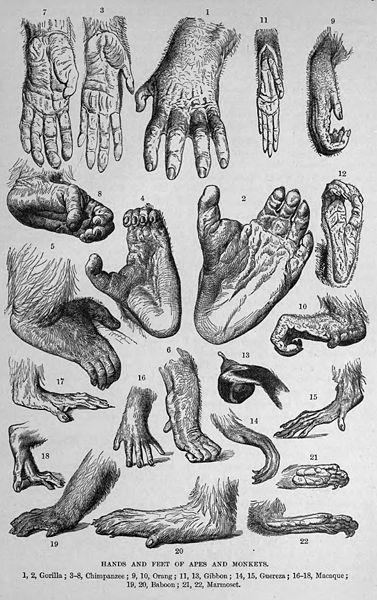
Human Difference
The Human Brain
The Human Brain
Humans have a larger brain than other animals ~ including their primate relatives.
Why is that? How has this feature come about?
Researcher, Hansell Stedman, has made an interesting discovery.
As part of his research into Muscular Dystrophy, he was studying the genes which made muscles ~ and, he found that, in humans, there was something not quite right.
In one gene, he discovered a mutation. Compared to other animals, there were 'two letters missing'.
Such a mutation might be expected to cause damage to the individual, yet it was one that all humans had, without any apparent muscle disease.
Stedman looked at the same gene in apes, and found that all four letters were in place. It was the same as any other muscle-making gene.
What muscle did this gene govern? Stedman found that, in apes, it made muscle for chewing, and for closing the jaw.
The lack of the two gene letters in this area, in humans, means that we humans chew with much less force than do apes.
Stedman concluded that this difference would also have another ~ very important ~ effect. He decided that the less powerful jaw muscle, in humans, could affect the evolution of the human brain.
How could this be?
The ape head, with its very strong large jaw muscles, is different from the human head. Ape skull plates fuse much earlier than human skull plates ~ at about 3-4 years in an ape, but at about 30 years in a human.
The result is that the human brain has more growing space, over a much longer period of time. As far as brain power is concerned ~ bigger seems to be much better!
This is another important area, where DNA, which is the same in other species, is very different in humans.
*
Source: Documentary 'What Darwin Never Knew'.
*
Our Primate Relatives

More Evolution and Genetics
More on Jaws
In April 2009, someone named Geoff posted some information to the Internet,about jaws and evolution, asking: 'what if our diets changed and our brains got bigger due to proto-human society dealing and adapting to an increasingly frequent and nearly catastrophic mutation of the jaw?'
This is a reference to the mutation discovered by Stedman.
This is how 'Geoff' explains it:
"There is a protein called myosin heavy chain 16 (aka MYH16) which in chimpanzees and other non-human primates is expressed almost exclusively in their powerful jaw muscles. ........
" ... Non-human primates have DNA that codes for the complete MYH16 protein. The corresponding part of human DNA is missing a random chunk – which causes a frameshift mutation." ...
"... a frameshift mutation occurred in early humans that affected the production of the protein MYH16. This protein is involved in the strong powerful jaws that primates have, but not humans."
* * * *
The original source ~ G Milburn on 'Human Evolution and Frameshift Mutations' ~ is not currently available at the original web address.
Ie:
http://www.gmilburn.ca/2009/04/03/human-evolution-and-frameshift-mutations

And Yet More On Jaws
This is from an article in 'The Guardian', by Timothy Taylor, re Peter Forbes.
"After the switch to an upright posture, probably the biggest single anatomical change on the journey from apes to humans was the weakening of the jaw ... and that weakened jaw enabled a raft of innovations."
It continues, that "The ape brain could not grow because of the huge muscle load anchored to the skull's crest, and apes cannot articulate speech-like sounds because of the clumsy force of their jaws. This mutation allowed the increase in human brain size and the acquisition of language".
How and why should such a mutation occur?
The article gives an explanation from Richard Wrangham, as explained in his book 'Catching Fire'.
What is that explanation?
'Wrangham maintains that it was cooking that led to the change. Cooked food does not need strong jaws. In genetics a function that becomes redundant always leads to the gene being disabled by mutations. Around 2.4m years ago an ape switched to mostly cooked food. In the fossil record, a new proto-human appeared 1.8-1.9m years ago: Homo erectus had a much larger brain and no crest on the skull, indicating that the weakened jaw muscle was now standard.'
Was it cooking that led to man?
Steve Jones has reviewed Wrangham's book and mentions 'claims that cooking led to our leaving the trees, to sex roles, to marriage, to emotional restraint, to consciousness, and to society itself ..', adding 'Anthropologists have a fatal tendency to decide, without much evidence, what made us human ...'
Jones notes:
'Homo sapiens is the culinary primate. Compared to apes, we are gutless; small mouths, weak jaws, modest stomachs and a large intestine only half the size of that of our relatives. Cooking means that food is in part digested before it gets into our mouths.'
'Primates with smaller guts have larger brains (and brains are expensive), and ours is the smallest of all, probably because cooking liberated our intestines from a large part of the drudgery of digestion. The spare energy went straight to our heads.'
But he maintains: 'The problem with making grand theories about the past is that they often rest on too few facts'.
Sources:
http://www.guardian.co.uk/books/2010/sep/04/artificial-ape-technology-timothy-taylor
http://www.guardian.co.uk/books/2009/oct/17/catching-fire-richard-wrangham-review

What Darwin Never Knew - Plus Related Items
Katie Pollard's Research
Katie Pollard is one scientist who has been studying DNA and brain evolution and she has found that more than half of 'switch' differences are 'near to a gene involved with the brain', including a gene affecting the cortex ~ the area of the brain concerned with music, language, mathematics, etc.
She found that 'small changes could have profound effects'.
Katie Pollard on the differences between humans and chimpanzees:
"... our DNA blueprints are nearly 99 percent identical to theirs. That is, of the three billion letters that make up the human genome, only 15 million of them—less than 1 percent—have changed in the six million years or so since the human and chimp lineages diverged. ....... somewhere among those roughly 15 million bases lay the differences that made us human."
http://www.scientificamerican.com/article.cfm?id=what-makes-us-human

DNA / Genes
HAR1
In the documentary, 'What Darwin Never Knew', Katie Pollard mentioned 'a massive mutation' ~ and it concerned the human brain cortex.
Scientists had found an area of DNA, related to development of the cortex, where there was a difference of 18 letters (18 base pairs) between chimpanzees and humans.
To put this into context, there was a difference of only two letters (2 base pairs) between chickens and chimpanzees, whose ancestors had branched apart 300,000,000 years ago, and which are nowhere near as closely related to each other as humans and chimps are. The ancestors of chimps and humans branched apart only 6,000,000 years ago, so these changes must have occurred relatively quickly and relatively recently.
Thus, in humans, it seemed that there were areas, where there had been unusually accelerated change. Since the documentary was made, these regions have been named 'Human Accelerated Regions' ~ or HARs. It seems that these are often 'switches' which have resulted in 'rapid, recent evolution'.
There are forty-nine HARs, but HAR1 concerns brain and neurological development and may help to explain 'the human difference'.
It has been suggested that HAR1 may be evidence of creation, rather than evolution, but scientists assure us that this is, in fact, evolution in action.
* * *
Sources:
What Darwin Never Knew

Wikipedia Quote
"Human accelerated regions (HARs), first described in August 2006, are a set of 49 segments of the human genome which are conserved throughout vertebrate evolution but are strikingly different in humans."

"The Human Brain Sets Man Apart"
"The human brain sets man apart. About 2m years ago it began to grow in size, and today it is about three times larger than that of chimpanzees, man's closest relative.
"Human intelligence and behavioural complexity have far outstripped those of its simian cousins, so the human brain seems to have got more complex, as well as bigger."
From: 'Man, Deconstructed' ~ published in 'The Economist', August 17th 2006, and quoted here:

How Humans Evolved
More Genes, DNA and Darwin
Two Million Years Ago
So, humans and apes branched six million years ago and human brains started to grow two million years ago.
What else was happening to humans two million years ago??
According to a headline in Science Daily, dated October 21st 2009, 'Tool-Making Human Ancestors Inhabited Grassland Environments Two Million Years Ago'.
Is this relevant to the brain changes, I wonder?
The article states that: 'Dr Thomas Plummer of Queens College at the City University of New York, Dr Richard Potts of the Smithsonian Institution National Museum of Natural History and colleagues report the oldest archeological evidence of early human activities in a grassland environment, dating to 2 million years ago' ~ 'at 'Oldowan archeological site of Kanjera South, Kenya'.
The article notes that: 'scientists as far back as Charles Darwin have thought that adaptation to grassland environments profoundly influenced the course of human evolution'.
http://www.sciencedaily.com/releases/2009/10/091020203420.htm
*
According to Wikipedia, it is '2.5 million years since the appearance of the genus Homo'.
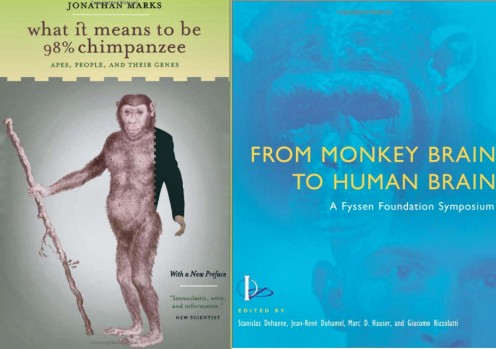
Book: 'From Monkey Brain to Human Brain'
This looks like a quality book, from a reliable source, which can educate us on the subject of the human - chimanzee difference.
'From Monkey Brain to Human Brain' is also sub-titled: 'A Fyssen Foundation Symposium'. It is edited by Stanislas Dehaene, Jean-Rene Duhamel, Marc D. Hauser and Giacomo Rizzolatti and was published in June 2005, by the MIT Press. (418 pages)
Amazon quotes from a review by Michael Posner. Posner, Professor Emeritus in Oregon University's Department of Psychology, calls it an 'amazing volume' and states that it 'modernizes Darwin by showing how closely the human and monkey brain are linked in morphology and genetics'.
Amazon quotes from a review by Guy A. Orban, Professor of Neurophysiology at Belgium's Catholic University Leuven Medical School. He refers to it as a 'remarkable volume', stating that it illustrates 'the striking similarities between our brain and that of our smaller cousins, even for higher cognitive functions'.
Amazon's 'Product Description' notes that 'The extraordinary overlap between human and chimpanzee genomes does not result in an equal overlap between human and chimpanzee thoughts, sensations, perceptions, and emotions' ~ in spite of the 'considerable similarities' there are also 'considerable differences'.
(The Fyssen Foundation encourages 'scientific inquiry into the cognitive mechanisms that underlie animal and human behavior'. )
*
If you go to Amazon, there is a facility to 'look inside' this book, in order to examine its contents.
Book: What it Means to be 98% Chimpanzee
This book looks as if it could be really thought-provoking!
'What it Means to be 98% Chimpanzee: Apes, People, and their Genes' by Jonathan Marks.
Published byUniversity of California Press ~ 1st edition, December 2002. (312 pages)
Amazon provides some reviews for this book, including one from the 'New England Journal of Medicine'. This one begins: 'Do not be deceived by the title of this book. ... being 98 percent chimpanzee means nothing: despite all similarities, chimps are chimps, and humans are humans'.
The writer, Guido Barbujani, adds: 'We have largely the same genes as chimpanzees, and these genes do the same things in much of our bodies, but in the brain, the patterns of gene expression diverge dramatically. ..... what it means to be human is a fantastically complex question .....'
The following is an extract from an Amazon review from 'Booklist': 'Humans share about 98 percent of our genetic makeup with chimps, which would be impressive ... if we could figure out what it means. We also share about half our genes with fish and about a third with daffodils, but almost no one argues that anything can be learned from fish and flowers about human behavior
*
Other books by Marks:
'Human Biodiversity: Genes, Race, and History'
'Why I Am Not a Scientist: Anthropology and Modern Knowledge'
'The Alternative Introduction to Biological Anthropology'
Evolution Hub From Another Hubber

Human Baby
The Role of God?
I can certainly understand why Christians see 'the human difference' and believe that God must be behind it, but which humans first displayed this difference?
~ Was it Homo erectus / ergaster?
Is that the species to which Biblical Adam and Eve were supposed to belong?
And genetics show that we are closely related to chimpanzees, so logic would tell us that, if God were involved, then it would have been to breathe special life into a type of ape, rather than to mould Adam out of the red earth.
To me, it seems logical and true that humans evolved from apes, but I still think that there is something of a mystery in our past and, indeed, many scientists are concentrating on researching the evolution and development of the human brain ~ which should answer many questions.
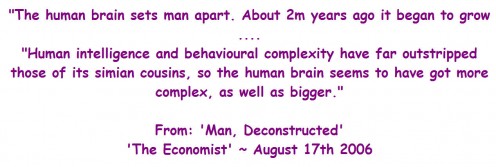
Ancient Aliens??
Ancient Aliens?
How did humans change from only having basic animal-like awareness to having complex human awareness?
Did advanced aliens come to earth in ancient times and cause mutations in the primitive apes, thus turning them into ... us?
Some people believe this theory to be true.
Some believe that there are items in the Bible which support it.
Here is an example from 'The Book of Genesis':
Genesis 6:1-4 (New International Version, ©2010)
'When human beings began to increase in number on the earth and daughters were born to them, the sons of God saw that the daughters of humans were beautiful, and they married any of them they chose. ......
'The Nephilim were on the earth in those days ~ and also afterward ~ when the sons of God went to the daughters of humans and had children by them. They were the heroes of old, men of renown.'
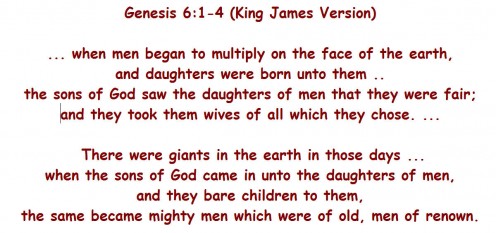
Dolphins and Elephants
Self Awareness
Self-awareness goes with intelligence.
Dolphins and elephants recognise themselves in mirrors from a quite young age and show a strong interest in their reflections.
Their behaviour with mirrors is much like our own.
And there are almost unbelievable claims that elephants can paint self-portraits!
Can those stories really be genuine?! Is it just good training?
Certainly, though humans may seem to be exceptionally aware and intellectual, we are not the only intelligent animals!
So, presumably, we did not need aliens to make us intelligent and aware.
Sources:
http://news.bbc.co.uk/1/hi/scotland/edinburgh_and_east/5203120.stm

More Primates
Conclusion - Do I Have My Answers?
No-one has all of the answers regarding the human difference. No-one really knows everything about this for sure.
Are we different, because we started cooking our food?
Is it because our brains can grow so large, owing to us not having very strong jaw muscles?
Is the difference somehow related to us moving onto the grasslands?
Is our HAR1 DNA responsible for all of the intellectual differences between us and the chimpanzees?
Is our ability to use our thumbs so dexterously behind our advanced intelligence?
Is it a combination of these factors?
Certainly they seem to go a long way towards explaining the important differences between humans and apes ~ including our closest relatives, the chimps.
Chimpanzee and human genes are very similar, but, in other parts of our DNA, there are major differences. Some differences have affected our thumbs, some have affected our jaws, and, consequently, our heads ~ and HAR1 DNA seems to have caused 18 base pair differences between humans and chimps.
So it is important to remember that, though our DNA is very, very similar to that of chimpanzees, it is definitely not identical ~ and it is the differences which cause the difference.
And the research goes on ...
Copyright Tricia Mason. All rights reserved
*
I am not a scientist and may well have made some errors. If so, do please excuse them ~ and let me know. That would be much appreciated. Thanks.
Clever Chimps!?

The Making of Mankind - Leakey
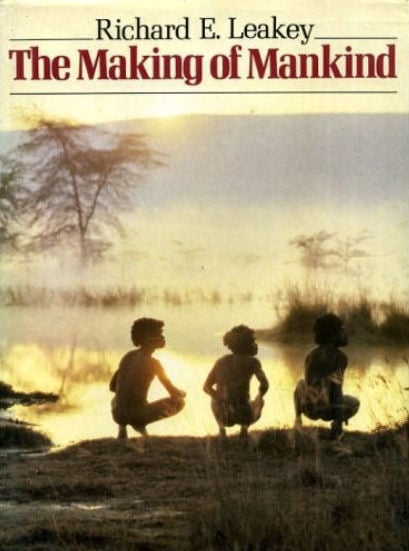
The Making of Mankind
My 'Evolution' Hubs
- The Facts of Life: Reproduction and Evolution
From a single cell, a new baby will develop. From a single-celled organism, all of complex life developed. - Evolution - Creationists Right and Darwin Wrong ??!!
National Geographic made a documentary about creationist arguments against Darwin. Here they are ~ plus a few extra ones! - Evolution - Could the Creationists Have Got It Right ??!!
The Creationists are convinced that God created life, just as described in the Bible ~ in the Book of Genesis. Could they be correct? - Brain Size, Evolution and Usage
Brain size and usage ~ a fascinating subject. The human brain , that is. I have often heard that we only use a small percentage of our brains. This set me thinking; nothing seems to... - Evolution and Creationism - My Take On Them and How I Arrived Here
Happy 202nd Birthday Mr Darwin! (12 February 1809 ~ 12th Feb. 2011) The Origins Debate: Mr Darwin, the creationevolution controversy began with you! Ever since your 'Origins', 150+ years ago, there has...
Bonobo - Cousin to Humans
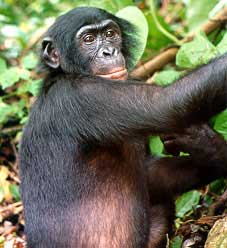
Related hubs from Other Hubbers:
Human-Like Gorilla
Bonobo Behaviour - Human-Like?
Relevant Links
- Nature news
- Jaw-dropping theory of human evolution
- Tool-making Human Ancestors Inhabited Grassland Environments Two Million Years Ago
- Catching Fire by Richard Wrangham | Book review | Books | The Guardian
- The Artificial Ape: How Technology Changed the Course of Human Evolution by Timothy Taylor | Book re
- Brain size and evolution: is there a valid correlation?
- NOVA | The DNA of Human Evolution
- What Makes Us Human?
- Human accelerated regions - Wikipedia, the free encyclopedia
- What Makes Us Human? Studies of Chimp and Human DNA May Tell Us | www.ucsf.edu
- Does the HAR1 gene disprove Evolution?
- Jaw-dropping theory of human evolution



